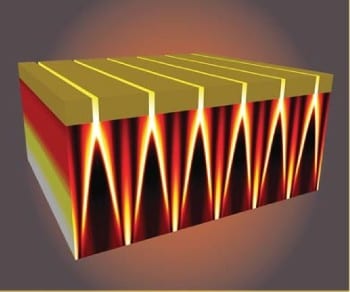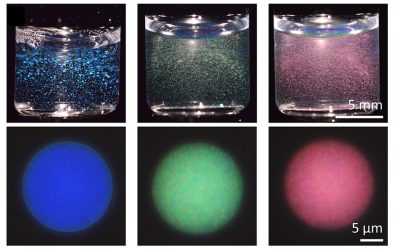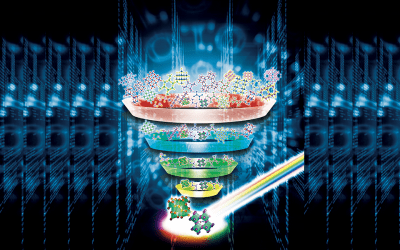Electromagnetic wave propagation in a uniaxial hyperbolic metamaterial evokes so called volume plasmon polaritons. Their interference leads to sub-wavelength patterns which could be used for nanophotolithography.
 Motivated by the problem of wave propagation in a plasma of electrons and ions under the influence of a magnetic field, and in particular, radio waves in the Earth’s ionosphere, in the 50’s and 60’s, electromagnetic wave propagation in a special type of anisotropic media with hyperbolic dispersion has been investigated intensely. Inside of such a hyperbolic medium, the principal components of the permittivity tensor have opposite signs causing the medium to exhibit a ‘metallic’ type of response to light waves in one direction, and a ‘dielectric’ response in the other.
Motivated by the problem of wave propagation in a plasma of electrons and ions under the influence of a magnetic field, and in particular, radio waves in the Earth’s ionosphere, in the 50’s and 60’s, electromagnetic wave propagation in a special type of anisotropic media with hyperbolic dispersion has been investigated intensely. Inside of such a hyperbolic medium, the principal components of the permittivity tensor have opposite signs causing the medium to exhibit a ‘metallic’ type of response to light waves in one direction, and a ‘dielectric’ response in the other.
Along with the anisotropic plasmas, stratified artificial materials were studied for applications in transmission lines. The fact that a broad spatial spectrum, including waves with a large wave-vector, can propagate in a hyperbolic media along one direction has been used to achieve extremely high spatial resolution. This property of hyperbolic materials, when used as an immersion lens, has been coined a “hyperlens”.
Vladimir P. Drachev, of Purdue University in West Lafayette, USA, now studied a uniaxial hyperbolic metamaterial – a lamellar metal-dielectric structure made of many thin planar layers of a metal and a dielectric, silver and silica – in a regime that allows for the observation of the interference between two spatially-confined transverse-magnetic waves propagating across the metal-dielectric interfaces.
Their experiments show that these highly localized waves, which they call volume plasmon polaritons (VPPs), propagate along the characteristic virtual interfaces separating the directions with distinct metallic and dielectric optical responses. This is similar to the propagation of conventional surface plasmon polaritons along the planar interfaces separating the isotropic dielectrics and metallic slabs. Interestingly, the plasmon polariton propagates along the resonance cone in a volume of hyperbolic metamaterial crossing the interfaces of the constitutive materials.
In a photolithography experiment, an interference of two VPPs from the double-slit was shown to result in a sub-wavelength pattern at the output interface, which is six times smaller than the free space wavelength at 465 nm. This is in sharp contrast to the double-slit experiment in silica, which results in a diffraction-limited pattern.
The hyperbolic material properties tend to be closer to the target effective parameters as the layering-period is decreased, providing potential pattern sizes of 22 nm. Such unique subwavelength interference patterns offered by hyperbolic metamaterials allow for a range of applications in nanophotonics. Drachev and his colleagues demonstrated a route to photolithography in their study. Another application field is sub-wavelength optical probe for sensing.

















